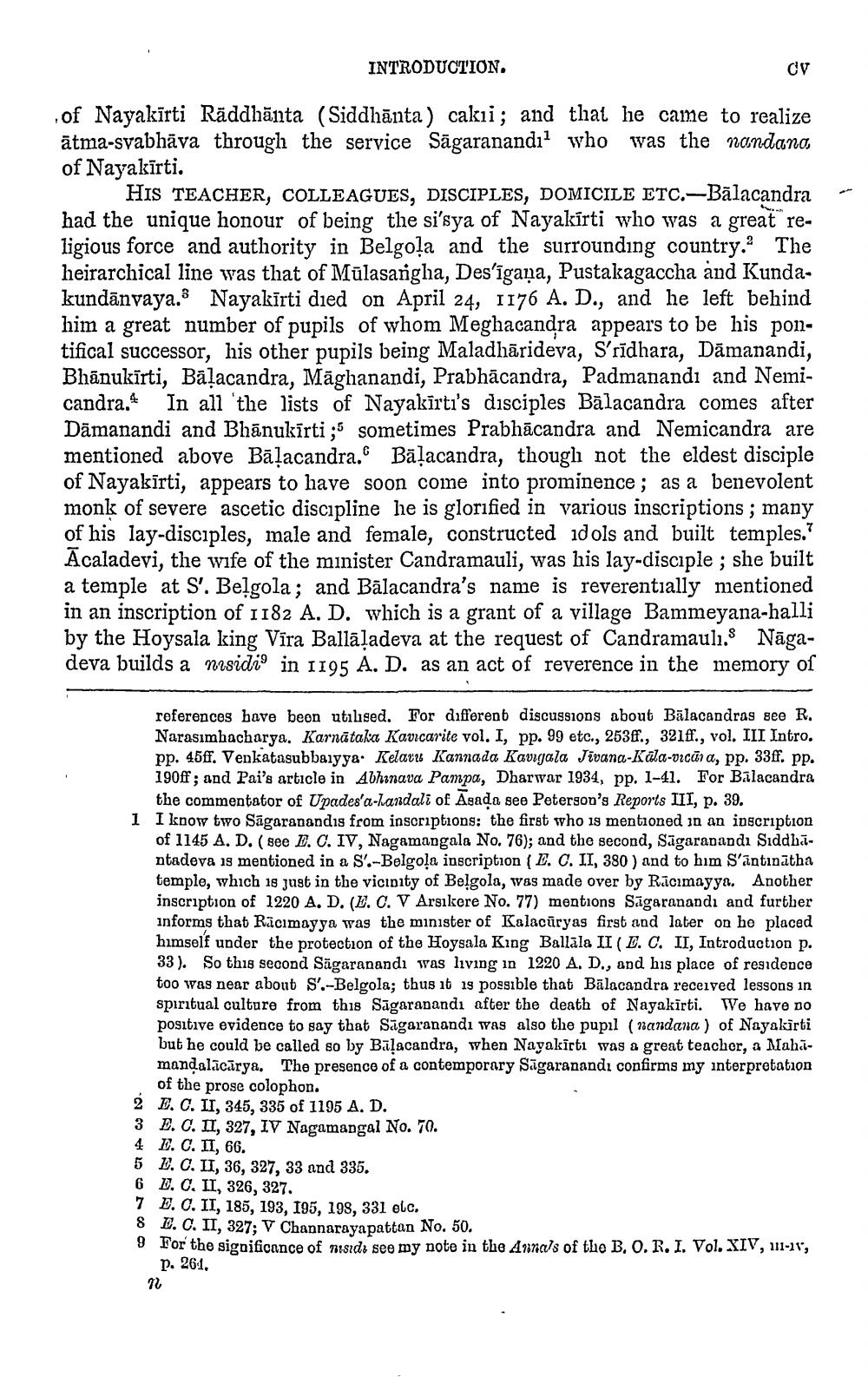________________
INTRODUCTION.
CV
-
of Nayakīrti Rāddhānta (Siddhānta) cakıi; and that he came to realize ātma-svabhāva through the service Sāgaranandı? who was the randana of Nayakīrti.
HIS TEACHER, COLLEAGUES, DISCIPLES, DOMICILE ETC.-Bālacandra had the unique honour of being the si’sya of Nayakīrti who was a great religious force and authority in Belgo!a and the surrounding country. The heirarchical line was that of Mūlasarigha, Deslīgaņa, Pustakagaccha and Kundakundānvaya. Nayakīrti died on April 24, 1176 A. D., and he left behind him a great number of pupils of whom Meghacandra appears to be his pontifical successor, his other pupils being Maladhārideva, S'rīdhara, Dāmanandi, Bhānukīrti, Balacandra, Maghanandi, Prabhācandra, Padmanandi and Nemicandra. In all 'the lists of Nayakīrti's disciples Bālacandra comes after Dāmanandi and Bhānukīrti ;5 sometimes Prabhācandra and Nemicandra are mentioned above Bālacandra. Bāļacandra, though not the eldest disciple of Nayakīrti, appears to have soon come into prominence; as a benevolent monk of severe ascetic discipline he is glorified in various inscriptions; many of his lay-disciples, male and female, constructed idols and built temples.) Ācaladevi, the wife of the minister Candramauli, was his lay-disciple ; she built a temple at S. Belgola; and Bālacandra's name is reverentially mentioned in an inscription of 1182 A. D. which is a grant of a village Bammeyana-halli by the Hoysala king Vira Ballāļadeva at the request of Candramauli. Nāgadeva builds a nusidil in 1195 A. D. as an act of reverence in the memory of
references bave been utilised. For different discussions about Bālacandras see R. Narasimhacharya. Karnātaka Kavicarite vol. I, pp. 99 etc., 253ff., 321ff., vol. III Intro. pp. 45ff. Venkatasubbaiyya. Keları Kannada Kavigala Jivana-Kala-orcūra, pp. 33ff. pp. 190ff; and Pai's article in Abhinava Pampa, Dharwar 1934, pp. 1-41. For Balacandra
the commentator of Upades'a-Landali of Agada see Peterson's Reports III, p. 39. I I know two Sāgaranandis from inscriptions: the first who is mentioned in an inscription
of 1145 A. D. (see D. C. IV, Nagamangala No. 76); and the second, Sagarapandı Siddhantadeva is mentioned in a S.-Belgola inscription (E. C. II, 380 ) and to him S'antinātha temple, which is just in the vicinity of Belgola, was made over by Racimayya. Another inscription of 1220 A.D. (E. C. V Arsikere No. 77) mentions Sāgaranandı and further informs that Racımayya was the minister of Kalacāryas first and later on be placed himself under the protection of the Hoysala King Ballāla II (D. C. II, Introduction p. 33). So this second Sāgaranandı was living in 1220 A. D., and his place of residence too was near about S'.-Belgola; thus 16 19 possible that Bālacandra received lessons in spiritual culture from this Sāgaranandi after the death of Nayakīrti. We have to positive evidence to say that Sagaranandı was also the pupil (handana ) of Nayakīrti but he could be called so by Būlacandra, when Nayakirti was a great teacher, a Mahamandalācārya. The presence of a contemporary Sāgaranandi confirms my interpretation
of the prose colophon. 2 E. C. II, 345, 335 of 1195 A. D. 3 E. C. II, 327, IV Nagamangal No. 70.
D. C. II, 66.
E. C. II, 36, 327, 33 and 335. 6 D. C. II, 326, 327. 7 B. . II, 185, 193, 195, 198, 331 elc. 8 D. C. II, 327; V Channarayapattan No. 50. 9 For the significance of misido see my note in the Annals of the B, O.R.I. Vol. XIV, 11-19,
p. 26:1.
qu




